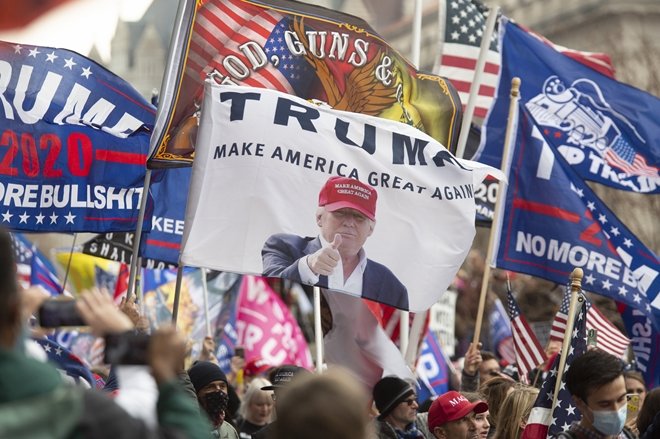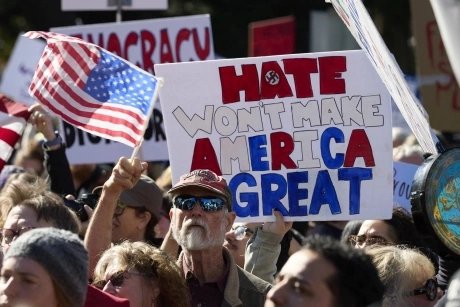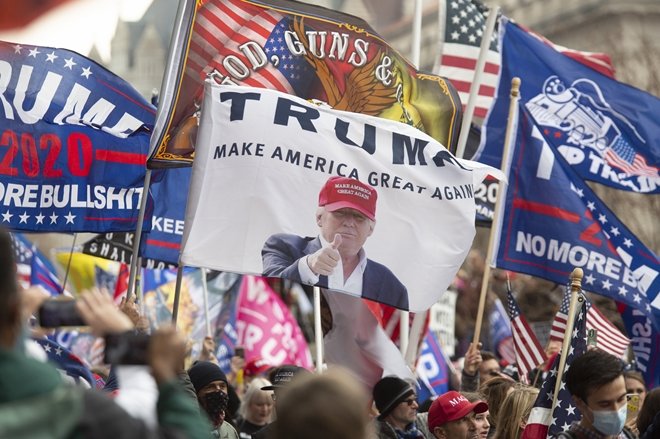In recent months, the United States has once again become a stage for widespread public demonstrations. This time, the target is former President Donald Trump. From New York City to Los Angeles, thousands of Americans have taken to the streets, voicing their opposition against what they perceive as the dangerous influence of Mr. Trump in the political and social fabric of the nation. These protests, although diverse in their makeup and messages, are united by a common cause: to prevent the return of Trumpism to the center of American power.
### The Root of the Protests: A Deepening Divide

At the heart of these protests lies a growing national divide that has festered since Trump’s first campaign in 2015. Supporters of the demonstrations argue that Mr. Trump’s political rhetoric, controversial policies, and disregard for democratic institutions have left a stain on American democracy. Critics point to his attempts to overturn the 2020 election results, his handling of racial justice protests, and his policies on immigration as evidence of authoritarian tendencies.
Many protesters view Trump as a symbol of regression — a throwback to a time of heightened division, racial tensions, and political instability. They argue that his potential return to the White House would be catastrophic for civil liberties, minority rights, and the democratic process.
### Who Are the Protesters?
The wave of protests has drawn a wide and diverse crowd. Young college students, veteran activists, union workers, teachers, immigrants, and even some disillusioned Republicans have joined the demonstrations. Many have traveled across state lines to participate in major rallies, holding banners with messages like “Democracy Not Dictatorship,” “No More Lies,” and “Never Again Trump.”
Social media has played a crucial role in organizing these events, with platforms like Twitter, Instagram, and TikTok serving as rallying points for protest information and political education. Hashtags such as #StopTrump2024, #ProtectDemocracy, and #ResistTheReturn have gone viral, amplifying the voices of those who believe the nation cannot afford another Trump presidency.
### A Closer Look at Key Cities

In **Washington, D.C.**, tens of thousands marched to the Capitol, the very building stormed on January 6, 2021. Protesters stood in symbolic opposition to what they describe as Trump’s continued threat to democracy. In **Chicago**, rallies emphasized his divisive immigration policies, with chants supporting DACA recipients and calling for more humane immigration laws.
**Los Angeles** saw massive turnouts from Hollywood celebrities, social justice organizations, and youth-led groups. Protesters flooded the streets holding signs urging people to vote and warning about the dangers of misinformation. Meanwhile, in **Atlanta**, civil rights leaders invoked the legacy of Martin Luther King Jr. to denounce Trump’s influence on modern politics.
### The Role of Trump’s Legal Battles
The legal challenges surrounding Donald Trump have added more fuel to the fire. With multiple indictments ranging from election interference to financial fraud, many Americans feel justified in their outrage. They question how a candidate facing serious legal scrutiny can remain a contender for the presidency.
Protesters argue that Trump’s continued presence in the political sphere undermines the justice system. “If an ordinary citizen committed these acts, they’d be in prison,” one protester in Philadelphia stated. “Why is Trump treated differently?” This sentiment has resonated with large swaths of the population who are increasingly skeptical of the perceived imbalance in accountability.
### Counter-Protests and Rising Tensions

It’s important to acknowledge that the protests against Trump have not gone unchallenged. In many cities, Trump supporters have organized counter-protests, waving “Make America Great Again” flags and accusing the mainstream media of bias. The confrontations between the two sides have, at times, turned violent, prompting law enforcement to intervene.
This clash of ideologies is emblematic of a nation in conflict. While one side sees Trump as a threat, the other views him as a savior who represents traditional values, economic nationalism, and a voice against political elites. The stark contrast has intensified the sense of urgency among those protesting against his return.
### The Role of Media in Mobilizing Protesters
Mainstream and independent media outlets have played a pivotal role in fueling the nationwide protests. Documentaries, interviews, and op-eds highlighting Trump’s controversial legacy have reignited public discourse. News organizations have aired footage of past Trump rallies, juxtaposing them with present-day demonstrations to provide historical context.
Moreover, investigative journalism has uncovered new details about Trump’s business dealings, connections to far-right groups, and his continued efforts to spread election denialism. These revelations have galvanized more Americans to take to the streets in protest.
### Voices from the Movement
Many protesters are not just marching — they are speaking out. Personal testimonies have become a powerful aspect of the movement. Maria Hernandez, an immigrant mother of three, said, “I came to this country for freedom and justice. Trump wants to take that away. I’m marching for my children’s future.”
Others, like 23-year-old student Jacob Reed, say they are driven by a desire to protect democracy. “This isn’t just about Trump. This is about what kind of country we want to be. Do we stand for truth, or do we allow lies to define us?”
Their words reflect the emotional and moral weight behind the protests. These are not just political statements — they are deeply personal declarations of fear, hope, and commitment.
### Political Implications for the 2024 Election

The growing protests could have significant implications for the 2024 presidential election. As Trump seeks to reclaim the White House, public sentiment expressed through these demonstrations could shape voter turnout, media coverage, and even policy discussions within both major parties.
Democratic candidates are increasingly aligning themselves with the protest movement, using their platforms to promise protection of civil rights and democratic norms. Meanwhile, some Republican candidates find themselves walking a tightrope — appealing to Trump’s base while trying not to alienate moderate voters disillusioned by Trump’s actions.
### Is America Heading for a Political Showdown?
With the protests gaining momentum, and Trump’s campaign intensifying, many political analysts predict a high-stakes showdown ahead. The nation appears to be approaching another tipping point, reminiscent of the social unrest of the 1960s or the post-9/11 political upheavals.
What’s different now is the immediacy and scale of public participation. Protesters aren’t waiting for political leaders to act — they are taking action themselves. From organizing town halls to launching voter registration drives, Americans across the country are mobilizing in a way that hasn’t been seen in decades.
### A Message Beyond Trump
Although the protests focus on Donald Trump, many participants are also calling for systemic change. They demand transparency, fairness in the justice system, protection of voting rights, and stronger safeguards against political corruption. In this sense, the anti-Trump protests are part of a larger movement seeking to reshape American governance.
Organizations like the American Civil Liberties Union (ACLU), Black Lives Matter, and grassroots environmental groups have found common ground in their opposition to Trump and their vision for a more equitable society.
### The Road Ahead: Unity Through Resistance?
While the United States remains deeply divided, the protests against Donald Trump demonstrate a form of unity among those who oppose him. This resistance may be chaotic and fragmented at times, but it reflects a collective desire to prevent what many see as the erosion of democratic values.
Whether these protests will succeed in preventing Trump’s political comeback remains to be seen. But one thing is clear: millions of Americans are no longer content to remain silent. Their voices are loud, their convictions are strong, and their message is unmistakable — they believe that the future of the nation depends on stopping Trump from returning to power.
**Conclusion: Democracy in Motion**
The thousands of Americans protesting against Mr. Trump are not just fighting one man. They are standing up for a vision of America that values truth, inclusion, justice, and integrity. In doing so, they remind the world — and themselves — that democracy is not a static ideal but a living, breathing force powered by the people.
As the 2024 election approaches, these protests may become a defining chapter in American political history. Whether they succeed or fail, they are a powerful testament to the enduring spirit of resistance and the unshakable belief that citizens have the right — and the duty — to hold their leaders accountable.
